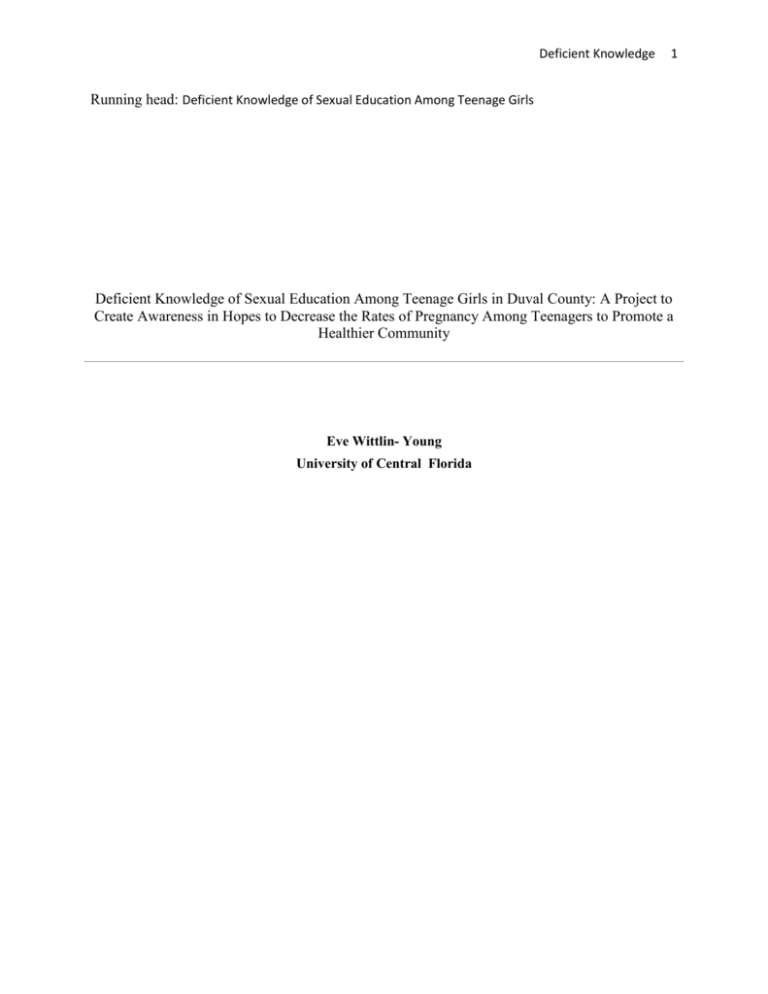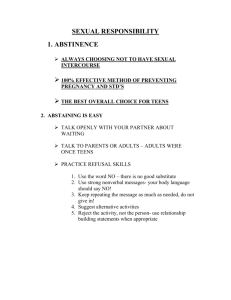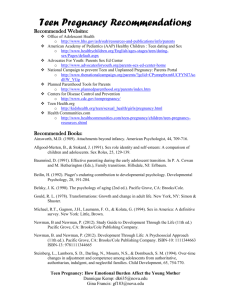
Deficient Knowledge
1
Running head: Deficient Knowledge of Sexual Education Among Teenage Girls
Deficient Knowledge of Sexual Education Among Teenage Girls in Duval County: A Project to
Create Awareness in Hopes to Decrease the Rates of Pregnancy Among Teenagers to Promote a
Healthier Community
Eve Wittlin- Young
University of Central Florida
Deficient Knowledge
2
Abstract
The United States holds the highest rates of teen pregnancy in the western industrialized world, with Florida
rated as the sixth highest in the nation (Family first aid, 2004). Incredibly, It is estimated that 750,000
American teenagers become pregnant every year (Tamayo, 2009). Even more disturbing, is the fact that after a
consistent and steady decline since the early 1990s, teen pregnancies and birth rates are on the rise with teen
pregnancy up 3% and birth rates showing a 5% increase (The National Campaign, 2010). This paper identifies
a community diagnosis, reviews the literature associated with teenage pregnancy and develops a detailed plan
in order to create awareness in Duval County and provide education to the teenagers of the community in
hopes to decrease the teen pregnancy rates to promote a healthier future for the community.
Deficient Knowledge
3
Deficient Knowledge of Sexual Education among Teenage Girls in Duval County
Part I: Community Diagnosis
Deficient Knowledge of sexual education among teenage girls in Duval County related to lack of exposure and
unfamiliarity with information resources as evidenced by high birth rates of teenage mothers’ ages 15 to 19 of
Duval County with a three year percentage of 50.3 compared to the state’s three year percentage of 42.5 and
Healthy People 2010 National Health Objective # FP HP2020–8 reduce the pregnancy rate of adolescent
females (Retained but modified from Healthy People 2010 objective 9-7) (USDHHS, 2010).
Part II Review of Literature
Why is this Diagnosis a Health Problem for this Target Group?
Teenagers in the United States are less likely to be aware of contraceptive methods, to know or
explore how to obtain and use contraceptives and to initiate action to protect themselves from unwanted
pregnancies from either before or just after their first sexual experience (Maurer & Smith, 2009). It is quite
unfortunate for this target group because many adolescents are just unaware that with teen pregnancy and birth
come many consequences, such as the fact that teen moms are less likely to complete high school, as statistics
show that only about one third of pregnant teenagers go on to receive their diploma (Swierzewski, 2007).
Another major consequence includes the fact that teen mothers are more likely to rely on welfare, with
statistics showing about eighty percent rely on welfare at some point in their life (Swierzewski, 2007). Other
consequences of teen pregnancy that studies conclude include children of teen mothers have lower birth
weights, are more likely to perform poorly in school and are at a greater risk for abuse and neglect (Maurer
&Smith, 2009).
Decreasing these rates of teenage pregnancy should be of great importance to all Americans, as teen
pregnancies cost the United States at least seven billion dollars annually from lost tax revenues, public
assistance, child health care, foster care and involvement in the criminal justice system (Swierzewski, 2007).
So as one can see, teen pregnancy not only effects the teens and their families but it affects the health and well
being of the entire community, which is exactly why this diagnosis is a major health problem for this particular
group.
Current Nursing Interventions for this Problem
Deficient Knowledge
4
According to Maurer & Smith (2009) community health nurses providing care to sexually active and
pregnant teenagers should use a balanced approach that consists of all levels of prevention, primary, secondary
and tertiary and because of their expertise in assessment, health teaching, and program development they are
most appropriate for providing sexual education to adolescents. Current nursing interventions for preventing
teenage pregnancy include concepts of sex and contraception content that at the very least provides
information about the anatomy and physiology of the reproduction system, abstinence only programs that
teaches abstinence as the only option for the unmarried and adolescents, comprehensive sex education that
provides a discussion of abstinence, contraception use and STDs, and lastly family life programs that offer
information on family systems and the interactions and influences among family members (Maurer & Smith,
2009).
Specific prevention programs available to teenagers from all levels of prevention include: Becoming a
Responsible Teen (BART) which is a community based program that aims to prevent HIV and includes
information on pregnancy prevention and abstinence, Life’s Walk Program that is a school based sexuality
abstinence only education that is taught in eighth and tenth grades, Safer choices intervention program that is a
comprehensive school based program developed with teacher, parent, child and community input, and
Children’s Aid Society-Carrera Program which is an intensive long term after school program for high risk
student that emphasizes future planning (Maurer & Smith, 2009).
What Interventions have been Successful and What Interventions have Not been Successful
There are many debates on whether providing sex education to adolescents will actually increase their
risks of beginning sexual activity instead of the desire of delaying the onset of teen sexual activity as well as
decreasing their risks of becoming pregnant. However, data does indicate that programs that provide a
comprehensive sex education that discusses abstinence, contraception and STDs provide a more balanced
approach in sex education and are shown to be more successful in prevention the prevention of teen pregnancy
and in fact do not encourage sexual activity (Maurer & Smith, 2009).
Interestingly, research does suggest that strengthening the education of teens in sex and the
consequences of sex may lead to less teen pregnancy (Science Daily, 2008). The Journal of Adolescent Health
Deficient Knowledge
5
(2008) had even completed a 2002 national survey of heterosexual teens from ages 15-19 and Kohler and her
colleagues had examined the results of this survey to discover that one in four teens received abstinence only
education and nine percent of the teens, particularly in rural areas had received no education at all. Teens that
were educated the study showed that they were incredibly sixty percent less likely to report being pregnant or
impregnating someone than those who receive no education (Kohler, Manhart, Lafferty, 2008). Even the Safer
Choices intervention program, that was implemented in California and Texas high schools, had reported that
teens in the program were 43% less likely to initiate sexual intercourse than nonprogram teens and sexually
active program teens were more likely to use contraceptives than nonprogram teens during a three year followup (Maurer & Smith, 2009).
With many studies exhibiting a relationship between positive exposure to sex education and a
decrease in adolescent sexual activity many programs are dedicated to support the funding for these
interventions. Specifically there are three federal programs dedicated to funding restrictive abstinence-only
education: Section 510 of the Social Security Act, the Adolescent Family Life Act’s teen pregnancy prevention
component and Community-Based Abstinence Education with a total funding of $176 million for these
programs (Guttmacher Institute, 2006). Also, President Obama’s FY 2011 budget proposal that was recently
released this past February provided continued investments in programs that help to reduce teen pregnancy
(National Campaign, 2010). This proposal includes 129 million dollars in funds for the teen pregnancy
prevention initiative, which is a 19 million dollar increase from the amount appropriated in FY 2010 (National
Campaign, 2010).
Part III Plan
Title: Deficient Knowledge of Sexual Education Among Teenage Girls in Duval County
Short Term Goal: Through implementation of educational sessions in the community high schools and from
information stands strategically placed in the community, nurses, student nurses, and volunteers will increase
the educational status and knowledge of Duval County teenagers about sexual education and teen pregnancy
prevention.
Deficient Knowledge
6
Three Measurable, Time Specific Learner Objectives:
1. At the end of a two hour teaching session in the community high school the teenagers will express that the
information presented in the pamphlet material, videos and/ or speaking appearance have encouraged them to
choose a healthier lifestyle and make informed decisions in their sex practices by stating that they will be
selecting abstinence and/ or safer sex.
2. At the end of a two hour teaching session in the community high school the teenagers will be able to discuss
the major risks of being sexually active, such as becoming pregnant and identify the challenges of being a teen
parent, such as stating the possibility of not obtaining their high school diploma.
3. At the end of a thirty minute lecture during an information stand visit the visiting teenager will be able to
indicate ways to prevent teen pregnancy, such as stating to choose abstinence and safe sex.
These goals and objectives specifically target teenagers of Duval County. I believe in order to decrease Duval
County’s teen pregnancy rates education is greatly needed amongst their teenage population. However, my
plan includes educating and creating awareness to not only the County’s teens but the entire community. In
order to make a significant difference in the community, the entire community must be involved. All must
work together with the same goals of lowering the County’s teen pregnancy and birth rates in order to promote
healthier children, a better community and a hopeful future.
I have devised a plan consisting of two segments to ensure that the greatest numbers of members in
the community have been reached. The first segment is designed to accomplish the goals of creating awareness
to the entire community by setting up several information stands strategically in the community. The
information stands will be placed at local churches and stores with pamphlet materials that will provide
information on abstinence, safe sex options, and also include the consequences of sex and the many challenges
of becoming a teen parent. Each information stand will be staffed with at least one specialized health care
provider that will be able to answer questions appropriately and a volunteer. Volunteers will consist mainly of
teen moms, nursing students and/ or other members of the community that would like to become involved in
this project. The second segment of the plan is constructed specifically for Duval County’s teenage population.
Deficient Knowledge
7
A community health nurse will complete public speaking at the local high school to provide sex education to
the attending teenagers. During the visit the nurse will be speaking of the many consequences of sex and
showing documentaries that will demonstrate the high demands and stress on a teenage parent, as well as
providing written material. Accompanying the community nurse to the high schools will include teen mothers.
These teen moms will be able to share their individual stories and speak to the teenagers in a truthful relatable
manner. This will clearly demonstrate to the teenagers that becoming pregnant can, in fact, happen to anyone if
sexually active, as most teens have the misconception that it can never happen to them. Also having teen moms
speak to the teens regarding their parenting experience will also clarify how difficult being a teen parent truly
is and will hopefully encourage teens to take precautions and prevent pregnancy.
Part IV Budget
Item
Price
Quantity
# of Hours
Total
Staff for local churches
Staff for local shopping centers
Pamphlet Material
Tables for information Stands
Sign Board (advertisement to attract community members)
Questionnaire Forms
Pens
Total
$12.00/ hr
$12.00/ hr
$1.00 each
$25.00 each
$10.00 each
$2.00
$2.00/ dozen
2
2
200 English and 100 Spanish
4
4
200 English and 100 Spanish
15
5
5
$120
$120
$300
$100
$40
$600
$36
$1316
Part V Nursing Process
Objectives
By the end of a two hour teaching
session in the community high
school the teenagers will be able to
summarize and express that the
information presented in the
pamphlet material, videos and/ or
speaking appearance have
encouraged them to choose a
healthier lifestyle and make
informed decisions in their sex
practices by selecting abstinence
and/ or safer sex.
Learning Domain
Cognitive
Topical Outline
Community health nurse will provide
sex education to the attending teenagers
at the local high school and discuss
ways to prevent teen pregnancy.
Primary Prevention: Educate the
teenagers of the community about sex
education and discuss the ways to
prevent teen pregnancy
At the end of a two hour teaching
session in the community high
school the teenagers will be able to
discuss the major risks of being
sexually active, such as becoming
pregnant and identify the
challenges of being a teen parent,
such as stating the possibility of
Cognitive
Community health nurse will discuss
the major risks of being sexually active,
such as the risk of becoming pregnant
and explain the many challenges of
being a teen parent, such as the
difficulty of obtaining their high school
diploma and the possibility of relying
on welfare.
Plan for Evaluation
By the end of the teaching
session the teenagers will
state at least two ways to
prevent teen pregnancy,
such as practicing safe sex
and choosing abstinence.
This will allow the nurse to
clarify any misconceptions
and also allow the nurse to
be sure that the teenagers
understand how teen
pregnancy can be 100%
preventable.
By the end of the teaching
session the teenagers will
identify the risks of being
sexually active and the
challenges of being a teen
parent by verbalizing at
least one risk, such as
becoming pregnant or
Deficient Knowledge
not obtaining their high school
diploma or relying on welfare.
At the end of a thirty minute
lecture during an information stand
visit the teenager/ visitor will be
able to indicate ways to prevent
teen pregnancy, such as stating to
choose abstinence and safe sex.
Primary Prevention: Educate the
teenagers of the many risks of being
sexually active and the challenges of
being a teen parent.
Cognitive
Nurse and volunteer will provide sex
education to community members by
lecturing at an information stand placed
at local churches and shopping plazas
in the community.
Primary Prevention: Educate the
members of the community about sex
education and discuss the ways to
prevent teen pregnancy in the
community
becoming infected with an
STD and stating at least
one challenge for a teen
parent such as the
possibility of not obtaining
their high school diploma.
By the end of the thirty
minute lecture during
information stand visit the
community members will
state at least one way to
prevent teen pregnancy,
such as practicing safe sex
or choosing abstinence.
References:
Family First Aid. (2004). Teen Pregnancy Statistics, Facts and Prevention. Retrieved
July 8, 2010, from http://www.familyfirstaid.org/teen-pregnancy.html
Guttmacher Institute. (2006). Facts on Sex Education in the United States. Retrieved July 6, 2010 from
http://www.guttmacher.org/pubs/fb_sexEd2006.html#31
Healthy People. (2010). Proposed HP 2020 Objectives Family Planning. Retrieved June 28, 2010 from
http://www.healthypeople.gov/hp2020/Objectives/TopicArea.aspx?id=21&TopicArea=Family+Planning
Kohler, P., Manhart, L., & Lafferty, W. (2008). Abstinence-only and comprehensive sex
education and the initiation of sexual activity and teen pregnancy. Journal of Adolescent
Health, 42(4), 344-351. Retrieved March 2010, from CINAHL Plus with Full Text database.
Maurer, F., & Smith, C. (2009). Community/ Public Health Nursing Practice: Health For
Families and Populations (4th ed.). St Louis, MO: Elsevier Saunders.
Science Daily. (2008). Comprehensive Sex Education Might Reduce Teen Pregnancies, Study Suggests.
Retrieved July 6, 2010, from http://www.sciencedaily.com/releases/2008/03/080319151225.htm
Swierzewski, S. (2007). Teen Pregnancy. Retrieved July 6, 2010, from
http://www.womenshealthchannel.com/teenpregnancy/index.shtml
Tamayo, L. (2009). Letter: Teen Pregnancy. Retrieved July 8, 2010 from
http://www.floridaplannedparenthood.org/news/letter-teen-pregnancy
The National Campaign. (2010). The National Campaign to Prevent Teen and Unplanned
Pregnancy. Retrieved July 8, 2010, from http://www.thenationalcampaign.org/national/
8






